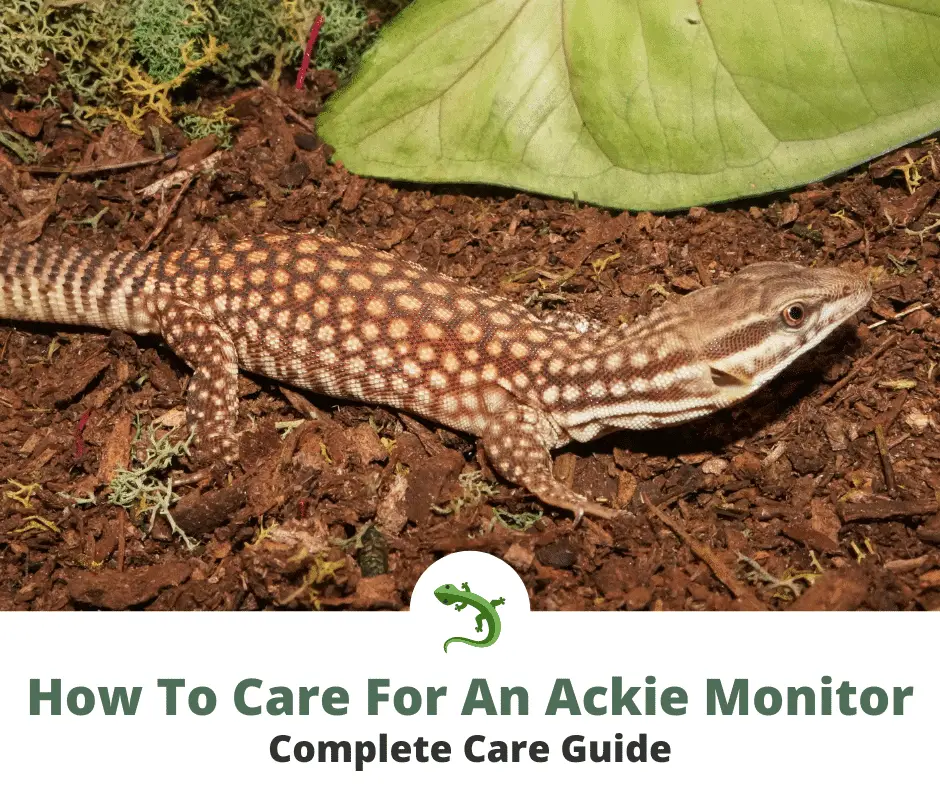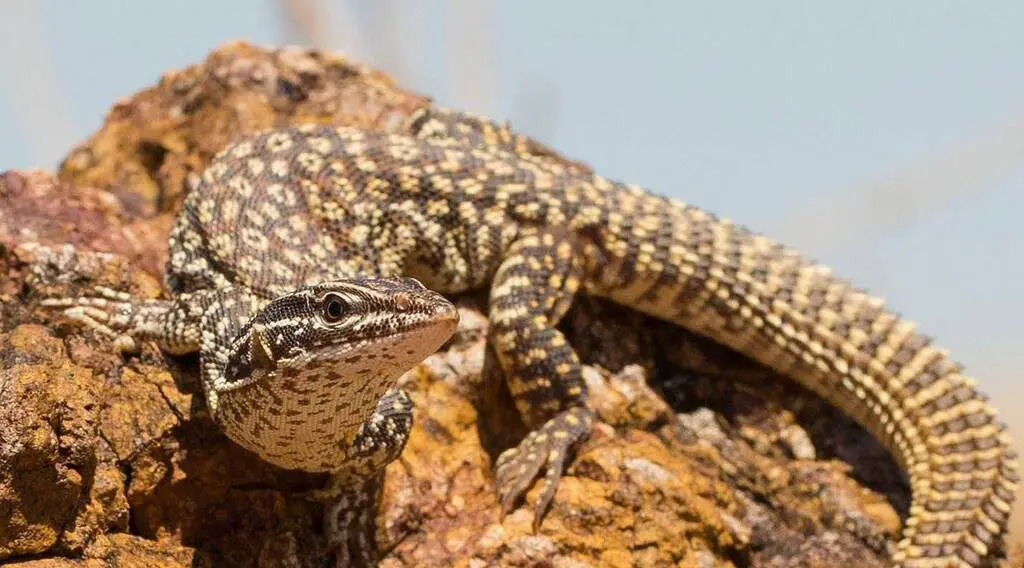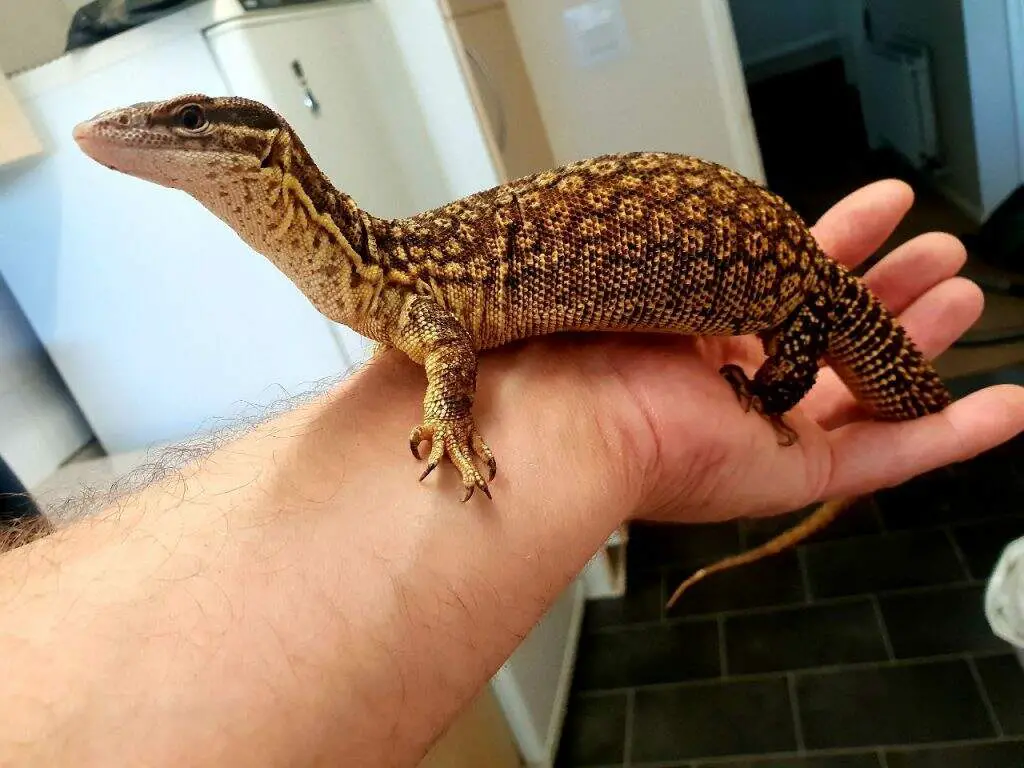Is the Ackie Monitor the right lizard for you? This guide will help you know what to expect and how to care for an Ackie Monitor.
In this guide you’ll learn:
- What type of enclosure do they need?
- How long do they live?
- What are their dietary requirements?
- What type of personality do they have?

Ackie Monitor Lizards are a crowd favorite among reptile owners for their attractive colors and patterns (red, yellow, and a few color morphs), moderate size, feisty looks, and inquisitive attitude. They have an uncanny resemblance with Komodo Dragons but obviously differ in size. They are also known as Ackies Dwarf Monitor. Other names include Ridge-Tailed Monitor and Spiny-Tailed Monitor because of the spiny scales on their tails and back.
If you’re intrigued by these reptiles and are considering them as pets, this guide will help you understand what to expect and help you with all the necessary information to provide the best care for your Ackie’s Monitor. They require the usual basic, reptile care with just a couple of considerations for their unique and charming traits. All in all, an Ackie’s Monitor has the potential to be an interesting and fulfilling pet with the right care, all of which are detailed below.

How To Care For Your Ackie Monitor
Ackie Monitors are considered quite hardy and can adapt well to life as pets. You should pay attention to setting up a good habitat that is as close to their natural environment as possible, with some unique requirements such as space for them to burrow. From there, it’s just a matter of time and patience to get your Ackie to warm up and bond with you.
As with all reptiles and lizards, providing the best care, from habitat to diet, will ensure they grow to their full size, be in the best of health, and reach their expected lifespan. Ackie Monitors tend to be hardy in captivity making them long-term commitment pets since they can live from 15-20 years when cared for properly.
Proper Habitat Setup
To build a proper habitat setup for your Ackie Monitor, keep in mind that they like to actively explore, hunt, bask, and burrow. They also tend to be clean freaks as a dirty enclosure will stress them out; so keep a good cleaning schedule for their tanks and stock up on disinfectants.
Enclosure Requirements (Types & Sizes)
Getting the correct tank or cage size for your Ackie Monitor is essential because of their unique trait of burrowing. They need taller tanks so you can keep their substrate deep and provide enough space for them to dig away happily.
A 48” x 24” x 24” tank or glass terrarium is recommended but if you can provide a taller tank, even better. Solid, durable, and thick glass tanks are best. The screen is usually on the top so the tank can be filled with substrate and maximized for burrowing.
Enclosure Cleaning
Ackie Monitors are particular about cleanliness, known as “clean freaks” in the reptile world. A dirty enclosure will stress out your Ackie Monitor making them moody and aggressive. Stress can also lead to diseases which can lessen the lifespan of your Ackie, so they definitely need a clean environment to thrive.
Spot cleaning is recommended every day with a full cleaning and disinfection done every month. If your enclosure is bio-active, with certain bugs that eat waste, you should still monitor the status of the tank and change the bedding a few times a year.
For a thorough cleaning, you should first remove your Ackie Monitor, tank furniture, and all substrate/bedding. You can then spray the tank with a reptile friendly disinfectant and wipe it off after. This step is usually done twice to ensure cleanliness. Each accessory should be cleaned in the same way – sprayed with disinfectant and dried off. You can also give it a good rinse with water before drying off.
It’s important to plan your cleaning activity during the day so that your Ackie Monitor will return to a warm enclosure and will not be too stressed out. If this is not possible, keep the basking lights on for at least an hour after cleaning before you turn it off for the night.
Lighting & Temperature
Ackie Monitors, like all reptiles, are cold blooded and will need a temperature gradient in their habitat to help them regulate their body temperature. Since they come from the dry, arid, regions of Australia, they tolerate up to 120 degrees Fahrenheit in their basking spots but will not do well in temperatures below 65 degrees Fahrenheit. So, investing in a good quality heater and light is essential to keep your Ackie Monitor in good health.
☀️ The hotter side of your habitat with a basking lamp should be between 110-120 degrees Fahrenheit with a nice piece of wood or cork bark stack to complete your Ackie Monitor’s basking zone. Ackie Monitors are diurnal and follow a normal 12-hour day/night (light/dark) cycle so be sure to turn off the basking lamp at night or invest in a timer. Keeping the light on will cause undue stress to your Ackie Monitor.
❄️ The cooler side of the habitat should be between 65-90 degrees Fahrenheit. Rocks or faux caves to hide in will help keep a good temperature variation in the tank that your Ackie Monitor can use to regulate its body temp. Again, make sure the temperature does not drop below 65 degrees. In places where it gets really cold at night, a ceramic heater or a good quality heat emitter is recommended.
A UVB lamp in addition to a basking lamp will provide your Ackie Monitor with Vitamin D3, which is an essential nutrient for reptiles to absorb calcium and prevent Metabolic Bone Disease (MBD). Make sure to replace your UVB lamp every 6 months. Since UV light is not visible to humans, you may not realize that your lamp needs replacement. Sticking to a replacement schedule is best to ensure your Ackie’s Vitamin D3 source.
Humidity
Ackie Monitors tend to prefer a higher humidity level of 65-85% but they like getting their hydration and humidity from the substrate as they burrow. To keep a good humidity level in the substrate, choose a kind that can hold their shape when lightly compressed such as coconut bedding and cypress chip bedding. These will help provide your Ackie Monitor the perfect burrowing experience to keep them relaxed and happy. Investing in a good quality hygrometer is also essential as cheap ones tend to be inaccurate. The right humidity level in the tank helps with their hydration and aids during shedding. Misting once a day will also help keep the humidity levels optimum.
Substrate & Furnishings
In the wild they burrow to escape the Australian desert heat and this instinct remains with them as pets. To accommodate burrowing, the substrate of your Ackie Monitor’s Habitat should be at least 6 inches deep or even as deep as 12 inches. This is why taller enclosures are preferred to house your Ackie Monitor. Deep substrates also help create good temperature gradients with the lower layers staying cooler than the upper ones.
Good substrate choices are reptile bark, coconut fiber bedding, and cypress chip bedding which hold their shape and moisture well. Reptile sand or soil can also be mixed in but some avoid this as sand can be ingested and can cause nasal or eye infections. Soil can also harbor some parasites.
Tank furnishings can be both decorative and useful. Rocks, half logs, wood planks, fake plants, bark stacks, caves, and moss beddings provide a variety of places for your Ackie Monitor to explore, hide, and bask in. Different elements in the tank enclosure will ensure a good temperature gradient to help your Ackie adjust their body temperature as it sees fit, aside from helping your Ackie feel safe and secure in its habitat. Create a nice basking spot for your Ackie by putting a log or a bark stack underneath the basking lamp.
Accessories
Accessories help mimic an Ackie Monitor’s natural habitat ensuring an environment suited for its needs, keeping stress and diseases at bay. Invest in natural decorations that recreate rock outcrops in the wild with crevices where they can hide or retreat in or cool down when hot. You can also use wood, cork bark stacks, artificial plants, and faux caves.
Food & Diet
A great thing about Ackie Monitors is they are not picky eaters and will actively seek for food. However, this also means that you should watch their weight since Ackie Monitors in captivity do not get the same exercise or activity in the wild. With their healthy appetites, this can lead to some weight problems. Small to moderate size meals can be fed to them everyday. Uneaten food should always be cleared to keep the tank clean.
Ackie Monitors will eat crickets, hissing cockroaches, lobster roaches, dubia roaches, mealworms, eggs (chicken, quail, and leopard gecko), shrimp, and raw turkey. Crickets and live prey should be dusted with a calcium supplement at least 2x a week for good bone health. Multivitamins can also be given weekly. Rodents (mice) can be given as treats from time to time (every 2 months). Another good treat is giving them live insects – Ackie Monitors will happily run around and hunt them for food. This may also be a good technique to help them trim down if they’re getting too heavy.
Water and Humidity
Water, along with keeping the correct humidity levels in the enclosure, is essential for your Ackie Monitor’s health, hydration, and proper shedding. Keep a large water bowl your Ackie can soak in with filtered and conditioned water that is kept clean at all times. Misting 1-2x a day will also help keep optimum humidity levels. Burrows can also be kept moist by spraying water into them when your Ackie Monitor is out and about.
Behavior & Personality
The temperament of Ackie Monitors are generally well suited for captivity. With slow and proper acclimatization, they will become comfortable and show no aggression except when they are in stressful situations which tend to put them in a mood. They can whip their tail or snap at you under stress and this usually happens when their environment is dirty – so always keep their tanks in tip-top shape! This means clean, well-lit tanks with a good temperature gradient, substrate, and correct humidity.
Ackie Monitors are inquisitive, intelligent, and curious and will sometimes observe the room through their tanks. They like to bask during the day and explore their habitat so make sure they have a variety of places to hide and burrow in to get comfortable.
Handling
With almost all lizards, patience is key during handling. The golden rule is to go at your lizard’s pace and take things slow with calm, confident handling on a regular basis or as tolerated. Give your new Ackie Monitor time to get used to and acclimatize in their habitat enclosure before trying to handle it.
Once you see your Ackie eating regularly with a good appetite, start to handle it a few minutes at a time, making sure to support their body with your hand. If your Ackie Monitor struggles and tries to hide or burrow after handling, give it some space and more time to warm up to you. If your Ackie hides for long periods of time after handling, decrease the handling time each day until it becomes comfortable again.
Once your Ackie Monitor continues to eat or looks relaxed after handling, then you can extend your handling time slowly but surely, until it remains relaxed out of its tank and becomes comfortable with being handled for longer periods of time.

Always remember to take things slow and never force anything with your Ackie Monitor. Let it get used to you at its own pace and build that trust slowly. With time, your Ackie will be more comfortable and tolerate, even enjoy, interacting with you. Just be patient and trust the process!
Common Health Concerns (Issues/Solutions)
Metabolic Bone Disease (MBD) is the most common health concern for lizards, including Ackie Monitors. This disease leads to brittle bones and deformities. By nature, lizards cannot metabolize calcium readily which is why Vitamin D3 is needed to help their bodies absorb calcium efficiently. A UVB lamp provides Vitamin D3 and calcium supplements given as dusting on crickets and other prey help prevent MBD.
Pricing and Availability
Ackie Monitors have been bred in captivity with success and are readily available outside of Australia. They have been sold in Europe by breeders since the 1990s. Because of this, they are not under any conservation threats. Even so, you should always check with your vet and get your lizards from reputable and responsible breeders.
Ackie Monitors are priced at $250-$500. Red Ackie Monitors are sometimes more expensive than Yellow Ackie Monitors because of their larger size and longer tails.
Even if you can get your monitor lizards at good prices, you should also consider the cost of caring for them and giving them the best possible life for them to thrive (maintaining the habitat, food, lamps, etc.) which can easily reach up to a thousand dollars a year. Also consider that these fascinating creatures can live up to 25 years making them a companion for most of your life.
Is an Ackie Monitor Right for you?
With the proper care, an Ackie Monitor will make a great pet for beginner to advanced reptile lovers. They thrive under basic reptile care with just a couple of unique considerations such as tall enclosures with thick substrate for burrowing. They are active and curious and are not picky eaters. With time and patience, Ackie Monitors will become tame and even playful.
If you can provide the detailed care listed above (and keep their habitat spotless), then you will truly appreciate and enjoy an Ackie’s Monitor Lizard as a pet.
Species Summary
Scientific name: Varanus acanthurus
Other names: Spiny-tailed Monitor, Ackies Dwarf Monitor, Ridge-tailed Monitor
Experience level: Beginner to Advanced
Average adult size: 24 to 48 inches (2 to 4 feet)
Lifespan: 15 to 20 years
Origin and Natural Habitat: Arid, dry regions and scrublands of Western Australia, Northern Territory, and parts of Queensland; rocky outcrops.
Types: Red Ackie Monitor, Yellow Ackie Monitor
Color and Distinguishing features: Brown with Yellow or Cream Colored Spots (Red Ackie Monitors are dark brown with a more reddish hue and yellow or cream colored spots); with spinose (spiky/spiny) scales on a rounded tail.
Food: crickets, roaches, and mealworms
Temperature range: 65 degrees Fahrenheit (cold side); 110-120 degrees Fahrenheit (hot side)
Humidity needs: 65-85%
Lighting: UVB, Basking Lamp, 12-Hour Light/Dark Cycle
Clutch Size: 7-18 eggs with up to 6 clutches per breeding season
Egg Incubation Period: 12-15 weeks (3-5 months)
Average price range: $250 – $500
Conservation Status: Not listed
Interesting characteristic: Burrowing
FAQs
How big do Ackie Monitors get?
Ackie Monitors are medium-size lizards that grow between 24-28 inches long with males growing a bit longer than females.
In the wild, there are some reports that they can grow up to 34 inches long, still dwarfed by their distant cousins, the Komodo Dragon, which can grow up to 10 feet. Proper diet, especially during their growth phase, and the correct tank size are two aspects you can control to ensure your Ackie Monitor reaches its full size. However, some genetics can come into play (e.g. females are slightly smaller) on how big they’ll eventually get. Their tails are usually 1-2 times as long as their bodies.
How long do Ackie Monitors live?
Ackie Monitor lifespan is 15-20 years.
Do Ackie Monitors make good pets?
Yes, Ackie Monitors make good pets. Children must be supervised with them because they can bite or claw. They are great for beginner reptile owners because they are not fussy eaters and don’t require expensive upkeep.
How big of a tank does an Ackie Monitor need?
A 48” x 24” x 24” tank or glass terrarium is recommended. It’s best to get as tall of a tank as possible because they love to burrow and create tunnels. Add at least one foot of substrate to your tank.
Can Ackie Monitors live alone?
Yes, Ackie Monitors can live happily alone. They don’t require a companion. If you house more than one make sure that you provide a deep substrate for them to burrow.
Do Ackie Monitors bite?
Yes, Ackie Monitors will bite. They have small teeth that can break the skin and their bite is painful. Over time, they can get used to being handled, but patience is key.
How much do Ackie Monitors cost?
Average price is around $250-$500 depending on where you purchase. Look for a reputable breeder and avoid big-box pet stores.


